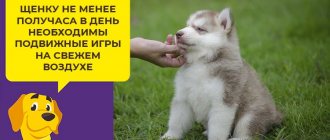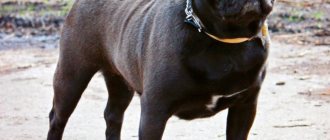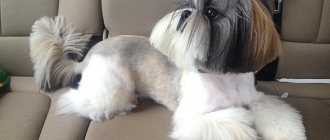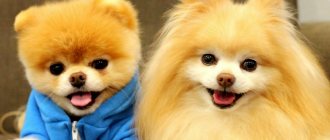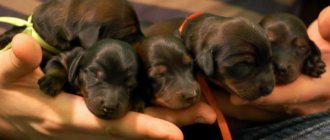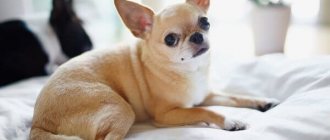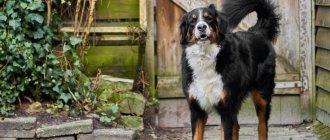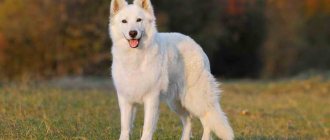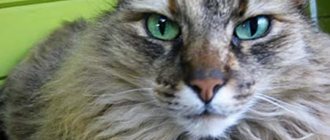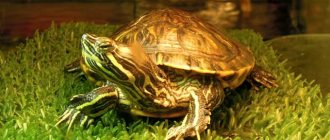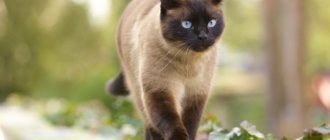First heat
Many dog breeders are interested in when the first heat begins in husky dogs. Interestingly, it is almost impossible to determine on what day the beginning of this period falls. Remember that in most cases, a husky's first heat begins after the change of teeth. To be as prepared as possible for this process and know how to act at the right time, talk to experienced breeders. Having found out the nuances that interest you, you can easily notice the first signs of estrus.
Popular colors of Siberian Huskies
If everything is very clear with the husky’s coat, it is straight, has medium length and a thick undercoat, then opinions are divided regarding the colors, because there are a large number of color variations. Foreign dog breeders count as many as 20 different colors, while Russian experts consider only white colors, combined with gray, black and brown tones, to be correct. Other colors of dogs are not considered defective; color diversity reigns among Siberian huskies.
In black and white, the percentage ratio of these two colors is almost the same. The dark color predominates on top, and white on the lower part of the body. This type of color is divided into two types. In the first type, complete pigmentation of the hairs is noticeable, and the undercoat has a black or gray tint. The second type involves half pigmentation of the hair and an undercoat of white or gray colors. Shades of red and brown are also often present in the colors of the Siberian Husky.
The brown-white color has different expressions, so it is divided into a couple of subspecies:
- Chocolate – brown color is dark and most saturated;
- Copper is lighter than the previous one, gives off a reddish tone, can be bright or muted in tone.
The red-and-white color is called red, it comes in different saturations, some dogs have a fiery hue, others have a muted, light red hue. The fawn color scheme is considered close to red; it is more faded and has beige, golden and cream tones. Gray coloring is also popular; the undercoat in this color can be cream, silver, gray or fawn.
The following varieties are observed in guard hairs:
- Only the ends of the hair are black;
- The tips have a faded black tint, so the dog's coat appears silver-blue;
- Black is combined with a whitish tone; sometimes this color is considered black and white.
The wolf (zonal) coloration predominated among the very first representatives of the husky; breeders were not interested in it, because She didn’t have much beauty. Controversial and rare colors of huskies include: black, white, agouti, harlequin, sable, black and tan, piebald, etc.
Frequency and duration
A Husky dog can go into heat at any time after changing teeth. Therefore, try to examine your pet daily for the appearance of characteristic discharge.
To do this, carefully check the bitch's loop. As soon as the discharge begins, mark this day in a special notebook. The duration of estrus is about 21 days. The next heat will take place after 4–7 months. Be sure to try to write down all the necessary data regarding the husky's discharge. Knowing how long estrus lasts, and what is the interval between these stages, you can prepare much better and more correctly for mating dogs.
Diet of Siberian Huskies
When purchasing a puppy, you immediately need to decide what food to give him: ready-made or home-cooked. If you settle on dry food, then you should refuse the cheapest one; it is better to choose a balanced composition that is suitable specifically for active dogs. For babies, it is better to use puppy food, which is well soaked in milk. The first place in the food composition should be meat or meat meal.
If you decide to feed your pet at home, then you should not forget that the main food for these dogs is raw meat; it is better to feed puppies with minced meat. Chicken is not advisable for huskies, it can cause allergies, it is better to give beef, turkey, rabbit. You can also feed dogs boiled offal. As for sea fish, it is given boiled, with all the bones removed.
Important fact: Every day the dog’s menu should include porridge with vegetable oil. Huskies eat vegetables both raw and steamed or boiled. Boiled eggs are often added to porridges and vegetable stews. Little puppies enjoy milk, and adult dogs prefer fermented milk products.
There are foods that are unacceptable for huskies; dogs should not be fed:
- Potatoes;
- Pork;
- Lamb;
- Legumes;
- Baking;
- Smoked meats;
- Pickles.
It is worth knowing that combining dry and homemade food is impossible; you need to feed dogs only one type. Puppies eat 5 or 6 times a day, and mature dogs - a couple of times a day. It should be noted that for a dog who lives outside in winter, the portions need to be increased.
Signs of the onset of estrus
In order for your Husky to become pregnant on time and be successful, you need to take every heat seriously. You can understand that your dog’s discharge has begun by the following main signs:
- During a walk, the pet visits the toilet very often. The bitch does this on an instinctive level, because in this way she leaves marks for the males. Keep an eye on your furry pet, otherwise she may become pregnant unplanned;
- Pay special attention to the behavior of the husky. During heat, the bitch behaves too actively, playfully, and in some cases can show aggression. In addition, she may not pay attention to her master’s commands at all;
- You can make sure that the husky’s estrus has really begun by carefully examining the dog’s genitals. As a rule, during this period her loop swells, and if you put a little pressure on it, a light pink discharge will appear.
Similar article: How long do huskies live at home and what does it depend on?
Continue to monitor your dog, and when the time comes, your Husky's pregnancy and birth will proceed without any complications.
Siberian Husky - description of the breed
Today, huskies are divided into three groups, including:
- Racing (sports);
- Exhibition;
- Riding.
According to the official standard, the sled representatives of the Husky are described, which, first of all, correspond to dogs bred in Britain. Siberian Huskies are medium in size. A male dog at the withers can reach a height varying from 54 to 60 cm; a female dog, according to the same parameters, can be from 51 to 56 cm in height. Dogs weigh respectively from 21 to 28 kg and from 16 to 23 kg. If you measure a dog from the side, the length of its body can vary from 110 to 120 cm.
The husky's head is small, rounded at the back of the head and gradually narrowing towards the eyes. The transition from the frontal part to the muzzle is clearly visible, the back of the nose has an even shape. The dog's muzzle is of medium length; you can immediately notice a uniform narrowing closer to the nose, which should not become very pointed or form a square. Many dog breeders have noticed that the husky's look is always interested and lively, the dog has a mischievous expression on its face in general.
The disadvantages of the breed in the head area are:
- The head is too massive, standing out too much compared to the body;
- Lack of a clearly defined stop;
- A very narrowed, or, conversely, too wide-sized muzzle;
- The presence of a black nose in huskies of red, gray and black colors, and brown in dogs with brown fur.
Charming dog eyes are medium spaced apart and almond-shaped. The color of the iris can be brown, blue, amber, yellowish, mosaic or heterochromic eye color is acceptable. Disadvantages in this area include very close-set eyes and highly oblique eyes.
The location of the dog's ears is quite high, the distance between them is small. Husky ears can be called erect, their direction vector is strictly upward, the tips are slightly rounded. If the ears are too bulky or spread out to the sides, this is a fault. If we talk about teeth, a husky must have a scissor bite.
The dog's neck is of medium length; during movement, its tilt pushes the husky's head slightly forward. The neck should not be excessively thick, very long or, conversely, very short. The whole figure of the husky is quite solid and noble.
Its main features are:
- The presence of a strong and deep chest (a husky’s heart is of considerable size);
- Possessing widely spaced ribs;
- Powerful back with a flat surface from the shoulder blades to the croup;
- The dog has a rather toned and elastic lumbar region.
Speaking of a dog's tail, it is worth noting that it can be different: slightly lowered when the husky is calm, and curved upward in the shape of a sickle when the dog is in an excited mood. A tightly curled tail is considered an external defect. The dog's limbs, both hind and front, should be straight, moderately spaced and parallel to each other. The elbows on the front legs are pressed against the dog's body; they should not turn out or in.
The hind knee joints are mobile, hock with clearly visible angles, located close to the ground. The size of the paws is medium, they have an oval, but not very elongated shape, and are equipped with thick-skinned pads. Next, let's move on to a description of the husky's coat, highlighting its main colors.
Preparation for mating
Before deciding on what day to mate husky dogs, be sure to check the health status of both partners.
To prepare the bitch for mating, a special test is performed to check the structure of the vagina. The next point that any dog breeder is recommended to take into account is the choice of territory for mating. In most cases, the bitch is brought into the dog’s territory, since it is in a familiar environment that he will behave actively. Immediately before breeding a Husky, it is recommended to give it a good walk, but not to feed it or overexert it with physical activity. The same applies to male Husky dogs.
Interesting facts about Siberian Huskies
The Siberian Husky dog is an amazing breed of dog, which over the years, or, more correctly, over the centuries, has turned from a working (sled) dog into a domestic one. Many are fascinated by the external attractiveness of these four-legged animals.
Having studied their history in more detail, you can learn a large number of interesting facts, some of which we list:
- Huskies are very friendly and have a dense coat. Eskimos used dogs to warm newborn babies;
- Huskies are real heroes; in 1925 they saved the city of Nome, located in Alaska, from a terrible diphtheria epidemic. No one except the dogs could bring the life-saving serum, because... Alaska was in the midst of an arctic storm. Brave dogs traveled many kilometers in forty-degree frost and snowstorms, but were able to help people who defeated the epidemic within five days;
- The most famous dogs were Balto and Togo. Everyone knows the Disney cartoon about Balto, and there is a monument to him in New York. In the small Alaskan town of Wasilla, a museum houses the body of Togo, which was embalmed;
- Huskies are popular actors who play roles in various films; it is worth remembering only “White Captivity”;
- Huskies are laconic, they don’t like to bark in vain and do it on rare occasions, but they are happy to howl and can do it masterfully;
- Huskies are characterized by heterochromia - different colors of the eye iris; one eye can be brown and the other blue. It all depends on the brown pigment in the eyes; if it is present in small quantities, then the color of the eyes is blue;
- Huskies are very resilient and agile team players. Dogs in a team of 6 to 8 individuals are capable of running about 250 km per day, their speed can vary from 25 to 35 kilometers per hour;
- Huskies are tireless runners; a dog weighing 25 kg during a competition can burn about 13.5 thousand calories per day. If dogs are compared on these indicators with cyclists participating in races, then we can say that athletes (people) spend half as many calories.
Pregnancy and childbirth
Giving birth to a Husky, like the entire pregnancy period, is a very stressful and delicate stage in the life of your four-legged pet. Only if you can provide full care for your pet, surround it with affection and care, will the bitch endure pregnancy without complications. This period lasts about two months. A pregnant dog should be at rest and eat well. Newborn Husky puppies are born on days 58–72 of pregnancy.
If this does not happen at the appointed time, then surgical intervention will be required, because we are talking about the health of not only the entire litter, but also the mother. Interestingly, husky bitches begin to produce milk immediately before giving birth - similar characteristics are unusual for representatives of other breeds, so in this regard, your pet is unique. Remember: breeding Huskies is not easy, the process is meticulous and requires a lot of attention. Some dog breeders want to achieve one specific goal - to engage in breeding as a business.
Similar article: How much does it cost and how to choose a husky puppy
It is quite possible that you will be able to make money from such activities. In any case, the health of dogs should always come first. Learn to care for your four-legged friend, from the moment of the first heat to the end of pregnancy, follow the basic recommendations of specialists, and newborn puppies will be born healthy.
History of the origin of Siberian Huskies
The Siberian Husky was bred by the indigenous population of the Russian Far North. The Chukchi really needed a dog that could not only overcome enormous distances, but also transport people and cargo from places where seasonal hunting took place to camps. The harsh northern climate finally shaped both the animal’s physique and the dog’s disposition.
Interesting fact: Back in the Neolithic era, the natives of the Far East, who hunted and fished, began to breed sled dogs. These northern territories used to be called “dog country”, because for a high-quality sled you needed at least 9 dogs. There were no problems with food for such a number of dogs; people specially dried and dried fish for them, which they caught in huge quantities.
Sled dog breeding began to develop even more strongly in the 17th and 18th centuries, when the active development of these areas by Russians began, who went in search of gold. People needed transport, so they switched to riding more massive and capacious sleds, which required even more dogs in the sled.
With the advent of the twentieth century, the breed began to spread beyond its familiar territories, all this thanks to the endurance of huskies, their coordination when riding in a harness and a fairly high speed of movement. During the Gold Rush, Americans increasingly began to purchase Siberian Huskies, bringing them to Alaska. Huskies were actively used by Alaskan mushers for sled dog racing.
Then the Siberian Husky breed began to develop and modernize in the USA, because... In the USSR, the selection of these sled dogs was considered unpromising. A new impetus that attracted attention to Siberian Huskies occurred within the exhibition area. Seeley and Demidoff brought to the show a beautiful dog, painted in black and white, which amazed the judges with its contrasting colors and bright blue eyes. In the 70s of the twentieth century, huskies began to be kept as pets.
Siberian huskies began to return to their native land (Russia) only in the 90s, the first dogs were brought from the Czech Republic and Belgium in 1995, after a five-year period there were already one and a half hundred of them, and all of them were purebred. It is worth noting that the name “husky” was assigned to dogs from the distorted word “eski”, which was used to call Eskimos.
Later, this was the name given to Eskimo huskies, which differ from the breed of dog we are describing. The adjective “Siberian” began to be used in the name of the breed when these dogs were brought to the North American continent so that Chukchi huskies would not be confused with Eskimos, and so the name stuck forever.
